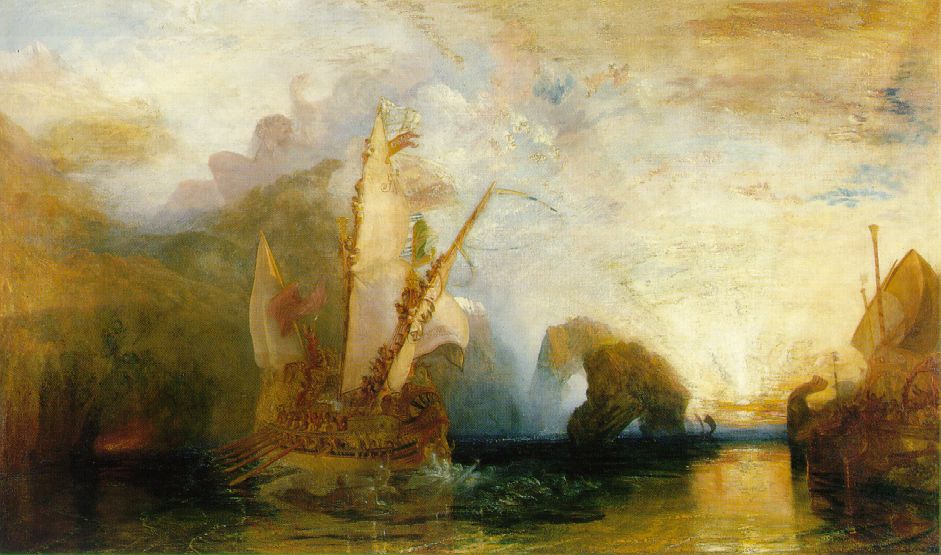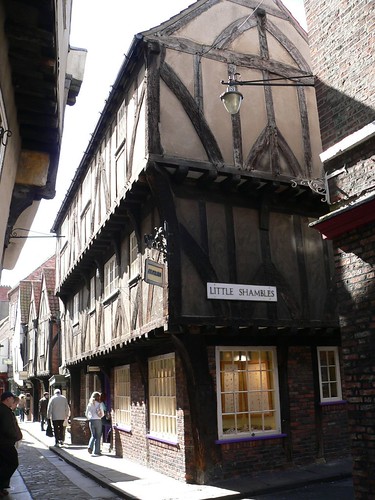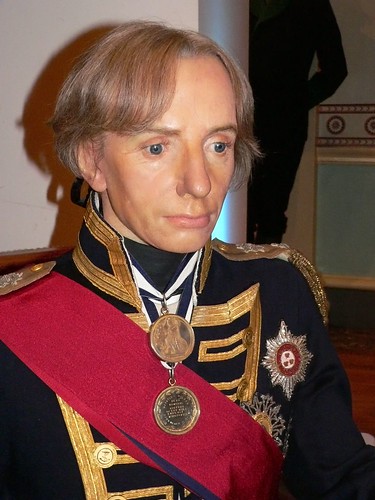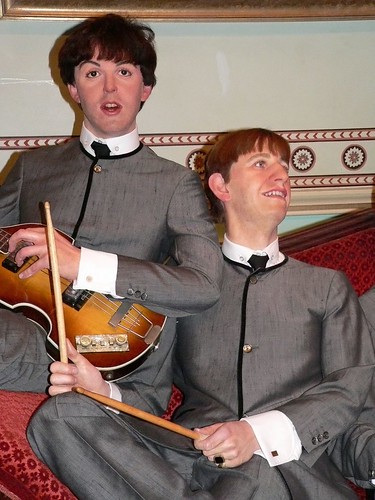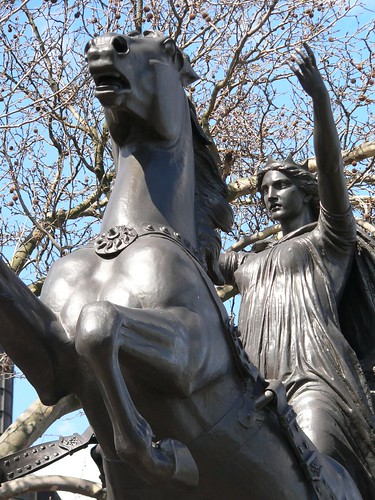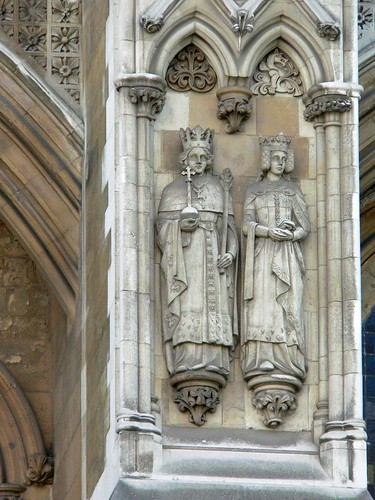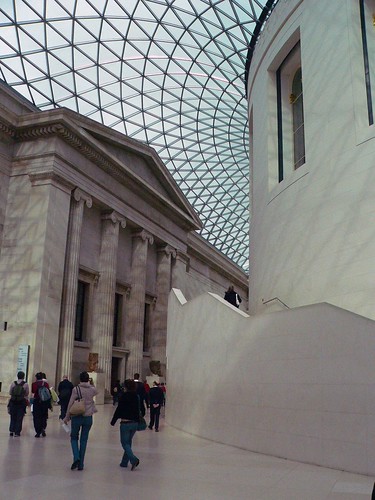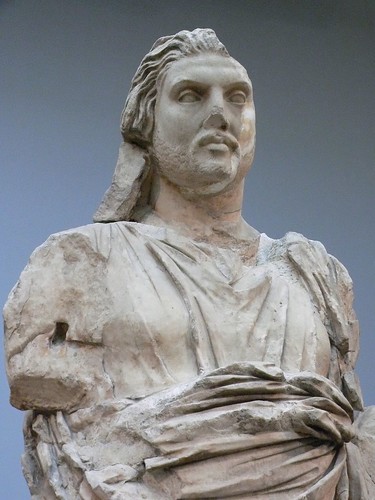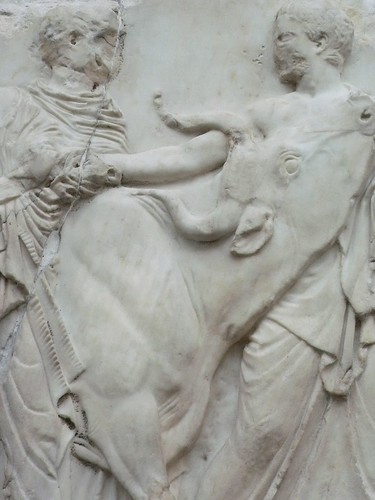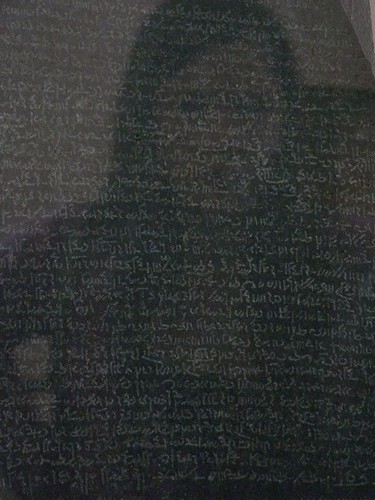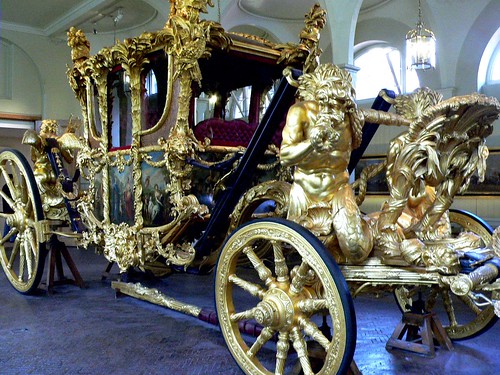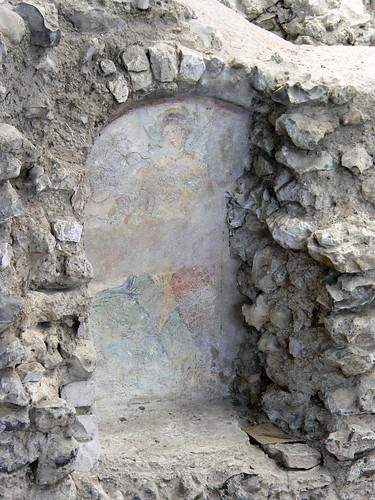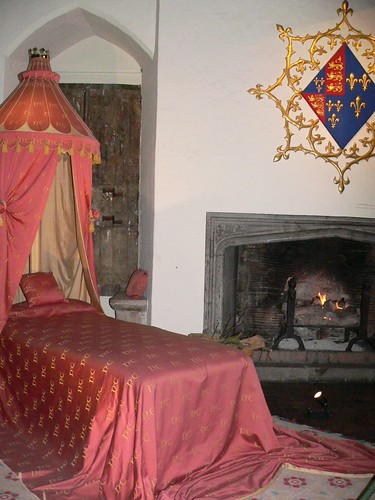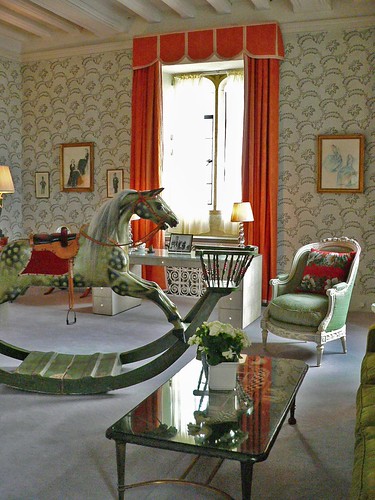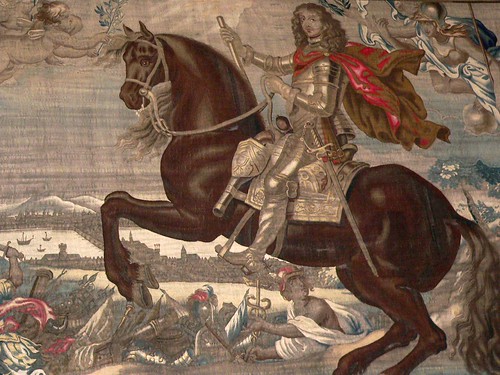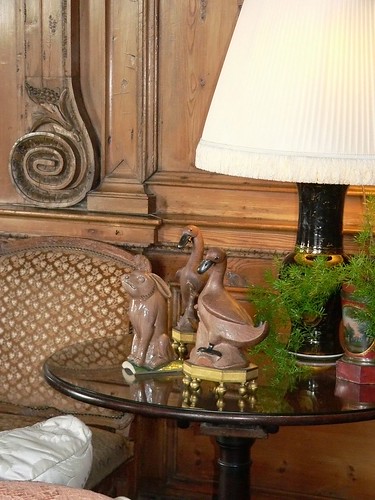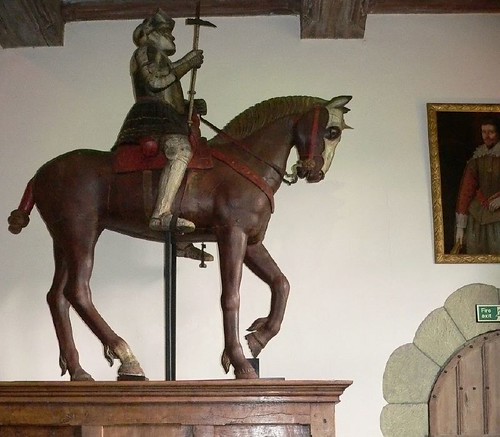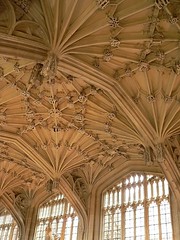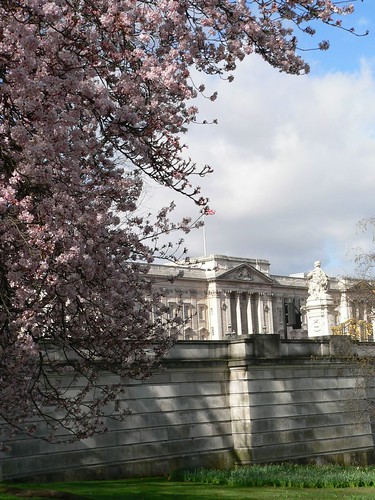 March 31, 2006: Well, we had our first full day here in London without having to deal with customs, trains, luggage, and taxis. We got an early start. After a continental breakfast of toast, cereal, fruit, and chocomilk (their version of milk and hot chocolate mixed) we met my friend and co-moderator of our Imperial Rome discu
March 31, 2006: Well, we had our first full day here in London without having to deal with customs, trains, luggage, and taxis. We got an early start. After a continental breakfast of toast, cereal, fruit, and chocomilk (their version of milk and hot chocolate mixed) we met my friend and co-moderator of our Imperial Rome discu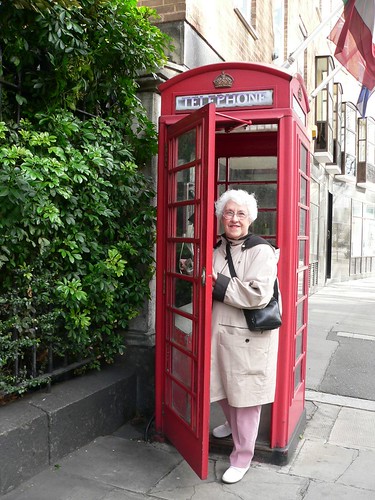 ssion group who had offered to take us on a London walkabout. We hiked around the local area photographing churches, window boxes, pubs, and phone booths (I'm afraid my sister here didn't know what I was talking about when I mentioned Dr. Who! She was never much of a sci-fi fan!) then we finally made it to Buckingham Palace. The Queen is in residence so visitors cannot go in this time of year but I got some nice shots of the exterior and Jane and I plan to return and tour the Queen's Mews (stables) and photograph the coaches later this week. The Royal Mews is closed on Friday (today) so we will have to find a spot in our schedule for our return visit. They also don't open until 11:00 and don't admit anyone after 3:15 p.m. this time of year so it is quite a challenge to find a time slot that won't disrupt an entire day. I'm sure it will be worth it though. I also hope to get some more pictures of the Victoria Monument.
ssion group who had offered to take us on a London walkabout. We hiked around the local area photographing churches, window boxes, pubs, and phone booths (I'm afraid my sister here didn't know what I was talking about when I mentioned Dr. Who! She was never much of a sci-fi fan!) then we finally made it to Buckingham Palace. The Queen is in residence so visitors cannot go in this time of year but I got some nice shots of the exterior and Jane and I plan to return and tour the Queen's Mews (stables) and photograph the coaches later this week. The Royal Mews is closed on Friday (today) so we will have to find a spot in our schedule for our return visit. They also don't open until 11:00 and don't admit anyone after 3:15 p.m. this time of year so it is quite a challenge to find a time slot that won't disrupt an entire day. I'm sure it will be worth it though. I also hope to get some more pictures of the Victoria Monument.
 We walked through St. James park enjoying the ducks, swans, and early flowering trees. It was pleasantly peaceful after the frenetic activity of Heathrow Airport and Paddington Station yesterday. We emerged near the palace entrance where the changing of the guard passes by in parade. It was pretty chilly so
We walked through St. James park enjoying the ducks, swans, and early flowering trees. It was pleasantly peaceful after the frenetic activity of Heathrow Airport and Paddington Station yesterday. We emerged near the palace entrance where the changing of the guard passes by in parade. It was pretty chilly so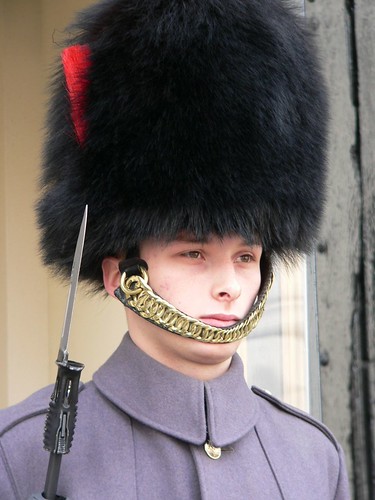 they were wearing gray overcoats but it was nice to get to see them. I couldn't get a good picture as the crowds were lining the street and I'm too short to shoot over their heads. However, we walked over to St. James palace and when we came around the backside there was a guardsman at his post. We waited until the crowd of tourists around him moved on then I was able to get several nice pictures of him including a closeup.
they were wearing gray overcoats but it was nice to get to see them. I couldn't get a good picture as the crowds were lining the street and I'm too short to shoot over their heads. However, we walked over to St. James palace and when we came around the backside there was a guardsman at his post. We waited until the crowd of tourists around him moved on then I was able to get several nice pictures of him including a closeup.
"Built largely between 1531 and 1536, St. James's Palace was a residence of kings and queens of England for over 300 years. It remains the official residence of the Sovereign, although, since the accession of Queen Victoria in 1837, the Sovereign has lived at Buckingham Palace. High Commissioners present letters and Ambassadors are still formally accredited to the Court of St. James's for this reason. The palace was built by Henry VIII on the site of the Hospital of St. James, Westminster. Much survives of the red-brick building erected by Henry VIII, including the Chapel Royal, the gatehouse, some turrets and two surviving Tudor rooms in the State apartments.
Buildings later sprawled to cover the area of four courts now known as Ambassadors' Court, Engine Court, Friary Court and Colour Court. The great Tudor Gatehouse at the southern end of St. James's Street still bears Henry VIII's royal cypher HR, surmounted by his crown, above the original foot passages leading through to Colour Court.
Henry VIII's illegitimate son Henry Fitzroy, whom he contemplated recognising

as his heir, was living in the Palace when he died in 1536 at the age of seventeen. From then on St. James's House, as it was known, saw a succession of Royal inhabitants who lived there while playing their part in some of the more famous events in English history.
Henry VIII's second wife, Anne Boleyn, stayed there the night after her coronation. Before she was discarded following the birth of Princess (later Queen) Elizabeth, the initials HA entwined in a lovers' knot appeared on a couple of Tudor fireplaces in the State apartments.
It was in St. James's Palace in 1558 that Mary Tudor signed the treaty surrendering Calais. Elizabeth I was resident during the threat posed by the Spanish Armada and set out from St James's to address her troops assembled at Tilbury, to the east of London." -
The Royal Residences We turned down a side street and looked down an alley and we saw an interesting looking courtyard. I noticed a sculptured portrait of a general that looked like Santa Anna. Sure enough, the building was once inhabited by the Texas legation after the Mexican American War but the monument was probably Sam Houston. If he knew I thought he looked like Santa Ana he would probably turn over in his grave!
We turned down a side street and looked down an alley and we saw an interesting looking courtyard. I noticed a sculptured portrait of a general that looked like Santa Anna. Sure enough, the building was once inhabited by the Texas legation after the Mexican American War but the monument was probably Sam Houston. If he knew I thought he looked like Santa Ana he would probably turn over in his grave!
"After Texas won its independence from Mexico in 1836, England was one of the first countries in the world to recognize the Republic of Texas as a nation. Their charge d'affaires to the Court of St. James, Dr. Ashbel Smith rented office space at 3 St. James's St in an upper floor above Berry Bros. and Rudd (who opened a grocers here in 1696) If you pop in you can see a large set of scales used to weigh coffee - nearby residents would also get themselves weighed here - the shop's ledgers record the weights of Lord Byron, Horatio Nelson, his mistress Lady Hamilton and Queen Victoria's father." -
The London Guide to SightseeingAs I don't like to feel guilty about indulging myself at exotic restaurants when I'm on vacation, I didn't bother to go in and tip the scales.
Then we walked on down to the exclusive shopping district at St. James Place and I got a chance to photograph a "beadle". Going back to Teutonic times, a beadle was originally an officer of the court or deputy for the local constable.
"After the Norman Conquest, the beadle seems to have diminished in importance, becoming merely the crier in the manor and forest courts, and sometimes executing processes. He was also employed as the messenger of the parish, and thus became, to a certain extent, an ecclesiastical officer, but in reality acted more as a constable by keeping order in the church and churchyard during service. He also attended upon the clergy, the churchwardens and the vestry. He was appointed by the parishioners in vestry, and his wages were payable out of the church rate. From the Poor Law Act of 1601 till the act of 1834 by which poor-law administration was transferred to guardians, the beadle in England was an officer of much importance in his capacity of agent for the overseers. In all medieval universities the bedel was an officer who exercised various executive and spectacular functions.
He still survives in many universities on the continent of Europe and in those of Oxford and Cambridge, but he is now shorn of much of his importance. At Oxford there are four bedels, representing the faculties of law, medicine, arts and divinity.
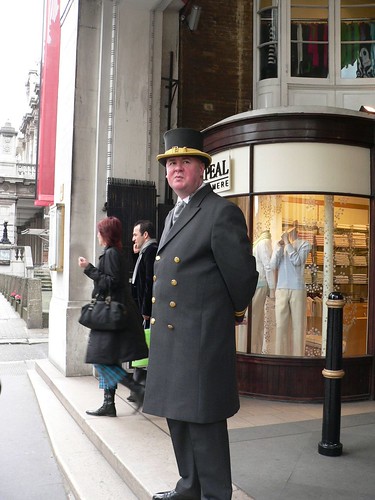
Their duties are chiefly processional, the junior or sub-bedel being the official attendant on the vice-chancellor, before whom he bears a silver mace. At Cambridge there are two, termed esquire-hedels, who both walk before the vicechancellor, bearing maces.
This beadle is a private security guard for the posh shops in this elegant upscale mall. I think his dashing suit and top hat are much more fetching than a guard's uniform!
Our guide, my friend Richard, joked with him about the local ordinance against whistling and singing. He promised the beadle that he would keep us under control!
We continued on to Picadilly Circus. There was a beautiful bronze fountain of plunging wild horses that photographed well and in one plaza there were bronzes of FDR and Winston Churchill sitting on a wooden park bench. We stopped to rest a bit in a little park that had a cute bronze of Charlie Chaplin. Then we continued on to Covent Garden. There we paused for a soda and listened to a quartet playing a selection of classical and turn-of-the-century songs including the E
bench. We stopped to rest a bit in a little park that had a cute bronze of Charlie Chaplin. Then we continued on to Covent Garden. There we paused for a soda and listened to a quartet playing a selection of classical and turn-of-the-century songs including the E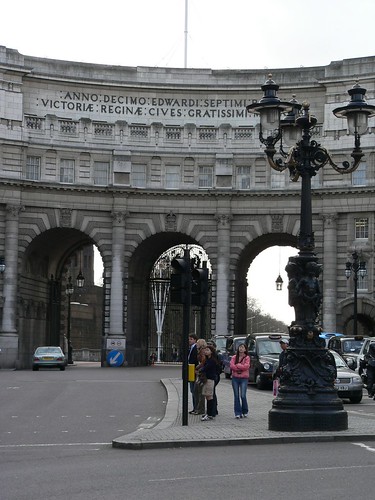 nglish Hornpipe. Then we struck out for Trafalgar Square. Of course I had to photograph the bronzes of famous British war heroes and the fountains in front of the London Gallery and Britain's own triumphal arch. We could also see Big Ben from there, too.
nglish Hornpipe. Then we struck out for Trafalgar Square. Of course I had to photograph the bronzes of famous British war heroes and the fountains in front of the London Gallery and Britain's own triumphal arch. We could also see Big Ben from there, too.
My sister was exhausted so we hopped on the underground and rode back to the station nearest our hotel. I noticed on the train there was a picture of a befuddled George Bush with the caption "Investing, like public speaking, is best left to the experts!"
We rested a bit then went out for dinner. We were wandering around reading menus and mumbling about fish and chips when this nice English boy spoke up and said if we really wanted good fish and chips we should go down to the Sea Fresh restaurant a couple of blocks away. We took his advice and dined on a very lightly breaded cod fillet with chips that was very good. The only thing I didn't care for was the fact that the fish was cooked with the skin on but the fillet was more like a large slab so I just ate above the skin and had plenty to eat.
It's an early day tomorrow as the Portobello Road street market opens at 5:30 a.m. (I think if we get there around 8 a.m. that would be fine as far as I am concerned!)
